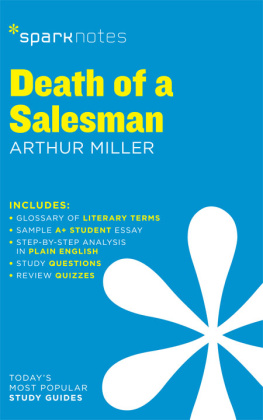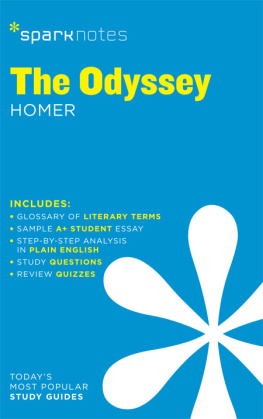Beowulf
2003, 2007 by Spark Publishing
This Spark Publishing edition 2014 by SparkNotes LLC, an Affiliate of Barnes & Noble
All rights reserved. No part of this publication may be reproduced, stored in a retrieval system, or transmitted in any form or by any means (including electronic, mechanical, photocopying, recording, or otherwise) without prior written permission from the publisher.
Sparknotes is a registered trademark of SparkNotes LLC
Spark Publishing
A Division of Barnes & Noble
120 Fifth Avenue
New York, NY 10011
www.sparknotes.com /
ISBN-13: 978-1-4114-7151-1
Please submit changes or report errors to www.sparknotes.com/errors.
10 9 8 7 6 5 4 3 2 1
Context
T hough it is often viewed both as the archetypal Anglo-Saxon literary work and as a cornerstone of modern literature, Beowulf has a peculiar history that complicates both its historical and its canonical position in English literature. By the time the story of Beowulf was composed by an unknown Anglo-Saxon poet around 700 a.d., much of its material had been in circulation in oral narrative for many years. The Anglo-Saxon and Scandinavian peoples had invaded the island of Britain and settled there several hundred years earlier, bringing with them several closely related Germanic languages that would evolve into Old English. Elements of the Beowulf storyincluding its setting and charactersdate back to the period before the migration. The action of the poem takes place around 500 a.d. Many of the characters in the poemthe Swedish and Danish royal family members, for examplecorrespond to actual historical figures. Originally pagan warriors, the Anglo-Saxon and Scandinavian invaders experienced a large-scale conversion to Christianity at the end of the sixth century. Though still an old pagan story, Beowulf thus came to be told by a Christian poet. The Beowulf poet is often at pains to attribute Christian thoughts and motives to his characters, who frequently behave in distinctly un-Christian ways. The Beowulf that we read today is therefore probably quite unlike the Beowulf with which the first Anglo-Saxon audiences were familiar. The element of religious tension is quite common in Christian Anglo-Saxon writings (The Dream of the Rood, for example), but the combination of a pagan story with a Christian narrator is fairly unusual. The plot of the poem concerns Scandinavian culture, but much of the poems narrative intervention reveals that the poets culture was somewhat different from that of his ancestors, and that of his characters as well.
The world that Beowulf depicts and the heroic code of honor that defines much of the story is a relic of preAnglo-Saxon culture. The story is set in Scandinavia, before the migration. Though it is a traditional storypart of a Germanic oral traditionthe poem as we have it is thought to be the work of a single poet. It was composed in England (not in Scandinavia) and is historical in its perspective, recording the values and culture of a bygone era. Many of those values, including the heroic code, were still operative to some degree in when the poem was written. These values had evolved to some extent in the intervening centuries and were continuing to change. In the Scandinavian world of the story, tiny tribes of people rally around strong kings, who protect their people from dangerespecially from confrontations with other tribes. The warrior culture that results from this early feudal arrangement is extremely important, both to the story and to our understanding of Saxon civilization. Strong kings demand bravery and loyalty from their warriors, whom they repay with treasures won in war. Mead-halls such as Heorot in Beowulf were places where warriors would gather in the presence of their lord to drink, boast, tell stories, and receive gifts. Although these mead-halls offered sanctuary, the early Middle Ages were a dangerous time, and the paranoid sense of foreboding and doom that runs throughout Beowulf evidences the constant fear of invasion that plagued Scandinavian society.
Only a single manuscript of Beowulf survived the Anglo-Saxon era. For many centuries, the manuscript was all but forgotten, and, in the 1700 s, it was nearly destroyed in a fire. It was not until the nineteenth century that widespread interest in the document emerged among scholars and translators of Old English. For the first hundred years of Beowulfs prominence, interest in the poem was primarily historicalthe text was viewed as a source of information about the Anglo-Saxon era. It was not until 1936 , when the Oxford scholar J. R. R. Tolkien (who later wrote The Hobbit and The Lord of the Rings, works heavily influenced by Beowulf) published a groundbreaking paper entitled Beowulf: The Monsters and the Critics that the manuscript gained recognition as a serious work of art.
Beowulf is now widely taught and is often presented as the first important work of English literature, creating the impression that Beowulf is in some way the source of the English canon. But because it was not widely read until the 1800 s and not widely regarded as an important artwork until the 1900 s, Beowulf has had little direct impact on the development of English poetry. In fact, Chaucer, Shakespeare, Marlowe, Pope, Shelley, Keats, and most other important English writers before the 1930 s had little or no knowledge of the epic. It was not until the mid-to-late twentieth century that Beowulf began to influence writers, and, since then, it has had a marked impact on the work of many important novelists and poets, including W. H. Auden, Geoffrey Hill, Ted Hughes, and Seamus Heaney, the 1995 recipient of the Nobel Prize in Literature, whose recent translation of the epic is the edition used for this SparkNote.
Old English Poetry
Beowulf is often referred to as the first important work of literature in English, even though it was written in Old English, an ancient form of the language that slowly evolved into the English now spoken. Compared to modern English, Old English is heavily Germanic, with little influence from Latin or French. As English history developed, after the French Normans conquered the Anglo-Saxons in 1066 , Old English was gradually broadened by offerings from those languages. Thus modern English is derived from a number of sources. As a result, its vocabulary is rich with synonyms. The word kingly, for instance, descends from the Anglo-Saxon word cyning, meaning king, while the synonym royal comes from a French word and the synonymregal from a Latin word.
Fortunately, most students encountering Beowulf read it in a form translated into modern English. Still, a familiarity with the rudiments of Anglo-Saxon poetry enables a deeper understanding of the Beowulf text. Old English poetry is highly formal, but its form is quite unlike anything in modern English. Each line of Old English poetry is divided into two halves, separated by a caesura, or pause, and is often represented by a gap on the page, as the following example demonstrates:
Setton him to heafdon hilde-randas....
Because Anglo-Saxon poetry existed in oral tradition long before it was written down, the verse form contains complicated rules for alliteration designed to help scops, or poets, remember the many thousands of lines they were required to know by heart. Each of the two halves of an Anglo-Saxon line contains two stressed syllables, and an alliterative pattern must be carried over across the caesura. Any of the stressed syllables may alliterate
















